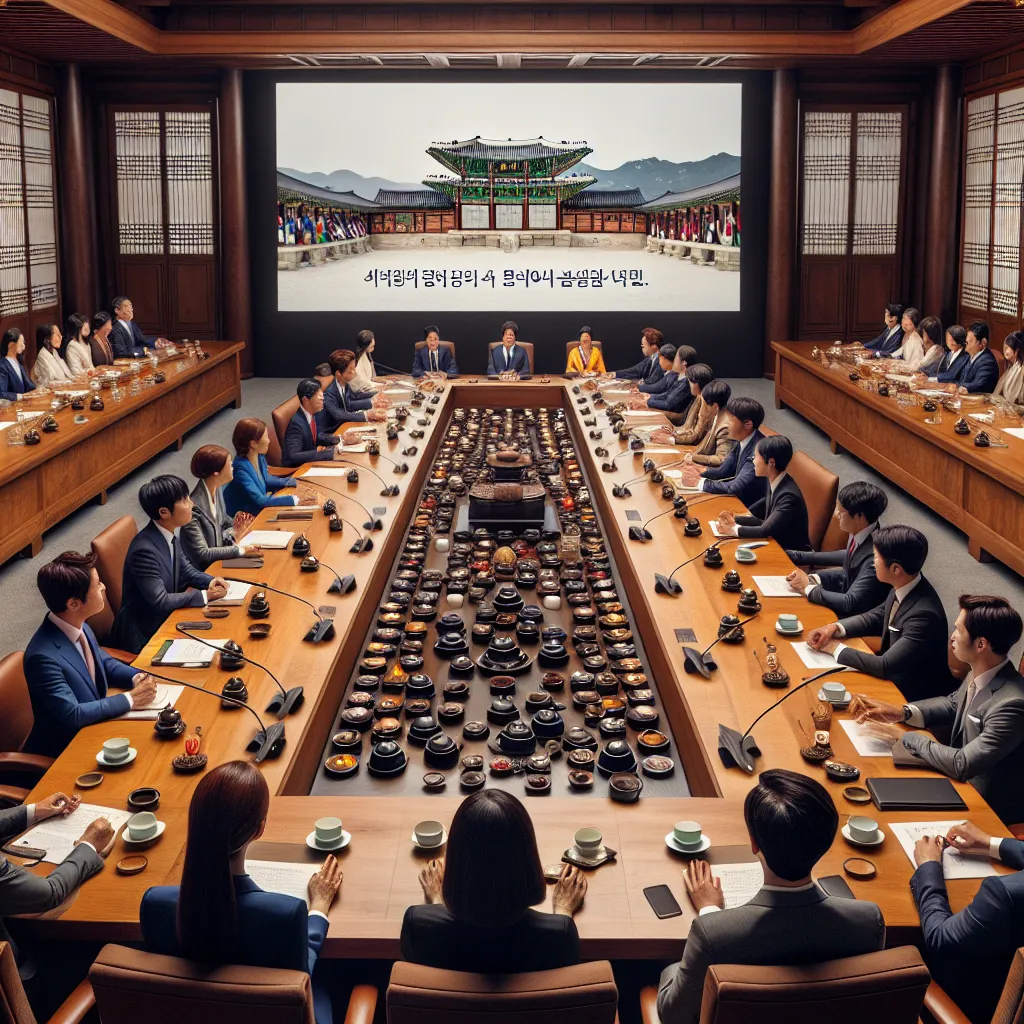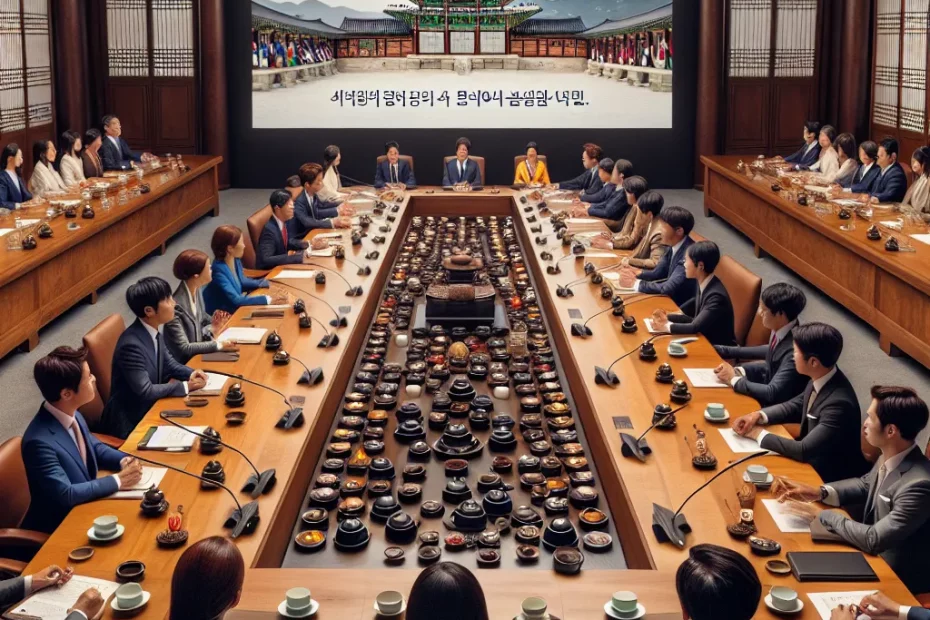Are you preparing for a business meeting in Korea and feeling a bit unsure about the cultural norms and etiquette? Don’t worry, I’ve got you covered! Understanding the nuances of Korean business culture is essential for successful interactions. From effective communication strategies to navigating hierarchies, there are key aspects to consider. Let’s dive into the dos and don’ts of Korean business meetings, so you can approach them with confidence and make a lasting impression. Embracing these practices will not only show your respect for the local customs but also help you build strong relationships with your Korean counterparts. Let’s explore how you can adapt seamlessly to Korean business settings!

Understanding Korean Business Culture
In the dynamic landscape of Korean business culture, understanding the intricate protocols and procedures is essential for successful interactions. With a strong emphasis on hierarchy, respect, and harmony, Korean business meetings follow a structured format that reflects the values deeply rooted in the society.
The Significance of Hierarchy
Hierarchy is a fundamental aspect of Korean business culture, where age, position, and status play a significant role in decision-making processes. It is customary to address individuals by their titles and show deference to those in higher positions. This hierarchical structure fosters a sense of order and respect within the business environment.
Did you know that maintaining harmony is crucial in Korean business meetings? Conflict is often avoided in favor of preserving relationships and group cohesion. Therefore, discussions may take longer as participants strive to find consensus and avoid direct confrontation. This emphasis on harmony highlights the collectivist nature of Korean society.
Punctuality and Business Etiquette
When it comes to punctuality, Koreans value timeliness and expect attendees to arrive on time for meetings. Being late is considered disrespectful and may create a negative impression. Additionally, exchanging business cards, known as “jeoncha,” is a common practice in Korean business culture. It is essential to present and receive business cards with both hands as a sign of respect.
Non-Verbal Communication and Networking
In Korean business meetings, non-verbal communication plays a crucial role. Paying attention to subtle cues such as body language, facial expressions, and tone of voice can provide valuable insights into the underlying messages being conveyed. Building rapport and establishing trust through non-verbal cues is key to successful business relationships in Korea.
Networking is an integral part of Korean business culture, where social connections are highly valued. Engaging in activities such as after-work dinners, known as “hweh-shik,” can provide opportunities to strengthen relationships outside the formal business setting. Building personal connections can lead to long-lasting partnerships and business opportunities.
In conclusion, navigating Korean business culture requires a deep understanding of the protocols and procedures that shape interactions. By embracing the values of hierarchy, harmony, and respect, individuals can foster positive relationships and achieve success in the dynamic Korean business environment. 🇰🇷💼
Effective Communication Strategies
Welcome to the world of Korean business meetings! In order to navigate these meetings successfully, it’s crucial to understand the protocols and procedures that are commonly followed. Effective communication lies at the heart of productive meetings, ensuring that all participants are on the same page and goals are achieved efficiently. Let’s dive into some strategies that can help you shine in Korean business meetings!
Active Listening
One of the key components of effective communication is active listening. In Korean culture, listening attentively to what others are saying is highly valued. Make sure to maintain eye contact, nod your head to show understanding, and ask clarifying questions to demonstrate your engagement.
Clear and Concise Communication
When expressing your thoughts or ideas, strive to be clear and concise. Avoid using ambiguous language or beating around the bush. Koreans appreciate direct communication that gets straight to the point, so be sure to articulate your message in a straightforward manner.
Utilize Data and Statistics
In Korean business meetings, presenting data and statistics can add credibility to your points. Numbers have a universal language that transcends cultural barriers. Backing up your proposals with relevant data can help you make a compelling case and garner support from your colleagues.
Establishing Rapport
Building rapport with your Korean counterparts is essential for effective communication. Take the time to engage in small talk before diving into business matters. Showing genuine interest in your colleagues and their culture can go a long way in fostering positive relationships.
Pay Attention to Nonverbal Cues
Nonverbal communication plays a significant role in Korean business meetings. Pay attention to subtle cues such as body language, facial expressions, and tone of voice. Understanding these nonverbal signals can provide valuable insights into the thoughts and feelings of your counterparts.
Respect Hierarchical Structure
Korean business culture places a strong emphasis on hierarchy. It’s important to show respect towards senior members by using appropriate titles and addressing them with honorifics. Acknowledging the hierarchical structure demonstrates your understanding and appreciation of Korean business etiquette.
Incorporating these communication strategies into your approach can help you navigate Korean business meetings with confidence and professionalism. Remember, effective communication is the key to building strong relationships and achieving success in the dynamic world of Korean business. Cheers to productive meetings and fruitful collaborations!
Business Meeting Etiquette in Korea
In Korean business culture, etiquette plays a crucial role in establishing and maintaining successful relationships. Understanding the protocols and procedures of Korean business meetings is essential for making a positive impression and fostering effective communication. Let’s delve into some key aspects of business meeting etiquette in Korea!
Formal Greetings
When entering a meeting room, it is customary to bow slightly as a sign of respect. The most senior person is usually greeted first, followed by others in descending order of seniority. Handshakes are also common, but it is best to wait for your Korean counterpart to initiate the gesture.
Punctuality
Punctuality is highly valued in Korean business culture. Arriving late to a meeting is considered disrespectful and may create a negative impression. It is advisable to arrive a few minutes early to demonstrate your commitment and professionalism.
Communication Style
Koreans value indirect communication and often use non-verbal cues to convey their thoughts. It is essential to pay attention to body language, tone of voice, and facial expressions during meetings. Additionally, maintaining a calm and composed demeanor is crucial, as losing your temper or showing frustration can be perceived negatively.
Documentation
Koreans appreciate thorough preparation and attention to detail. It is advisable to bring multiple copies of any documents or presentations to distribute during the meeting. Taking notes during the discussion shows respect and attentiveness to the topics being addressed.
Business Meals
Business meetings in Korea often involve meals, which are seen as opportunities to build relationships and socialize. It is customary to wait for the most senior person to start eating before you begin. Remember to use both hands when passing or receiving dishes and to show appreciation for the meal.
Decision-Making Process
In Korean business culture, decisions are often made collectively, with input from all team members. It is essential to be patient and diplomatic during discussions, as rushing the decision-making process can be perceived as disrespectful.
Follow-Up
After a business meeting, it is customary to send a follow-up email or message thanking your Korean counterparts for their time and insights. Expressing gratitude and reiterating key points discussed during the meeting can help strengthen the relationship.
By understanding and adhering to the etiquette of Korean business meetings, you can navigate professional interactions with confidence and respect. Remember, building strong relationships is key to success in the Korean business world! 🇰🇷🤝
Navigating Business Hierarchies
In the realm of Korean business meetings, understanding and navigating the intricate hierarchies is crucial for successful interactions. The concept of seniority and respect for authority plays a significant role in shaping the dynamics of these meetings. It is customary to address individuals by their titles and use formal language to show respect. For example, using titles like “Team Leader Kim” or “Director Park” adds a level of professionalism to the conversation.
Seating Arrangements
Furthermore, seating arrangements during meetings also reflect the hierarchical structure within the organization. The most senior member typically sits at the head of the table, with others seated based on their rank or importance. Observing these seating arrangements and following suit can demonstrate your understanding and respect for the hierarchy within the organization.
Decision-Making Processes
Additionally, decision-making processes in Korean business meetings often involve consensus-building among the team members. It is common for the most senior member to lead the discussion and for others to provide input and feedback. This collaborative approach fosters a sense of unity and teamwork within the organization.
Conflict Resolution
Moreover, maintaining a sense of harmony and avoiding confrontation is essential during Korean business meetings. Conflicts are typically addressed indirectly, with an emphasis on preserving relationships and saving face for all parties involved. By approaching disagreements with tact and diplomacy, you can navigate potential conflicts and maintain a positive atmosphere during the meeting.
In conclusion, understanding and respecting the hierarchical structures, customs, and communication styles in Korean business meetings are vital for building strong relationships and achieving successful outcomes. By embracing these protocols and procedures, you can navigate the complexities of Korean business culture with confidence and professionalism. 🌟🤝🇰🇷
As you navigate Korean business meetings, remember that understanding and respecting Korean business culture is key to building successful relationships. Effective communication strategies, such as active listening and non-verbal cues, can help bridge any cultural gaps. When it comes to business meeting etiquette in Korea, always prioritize showing respect to senior members and follow hierarchical protocols. By adapting to Korean business hierarchies, you can demonstrate your professionalism and build trust with your Korean counterparts. Remember, every interaction is an opportunity to learn and grow, so approach each meeting with an open mind and a willingness to adapt. Embrace the cultural nuances and enjoy the journey of building strong business relationships in Korea!
